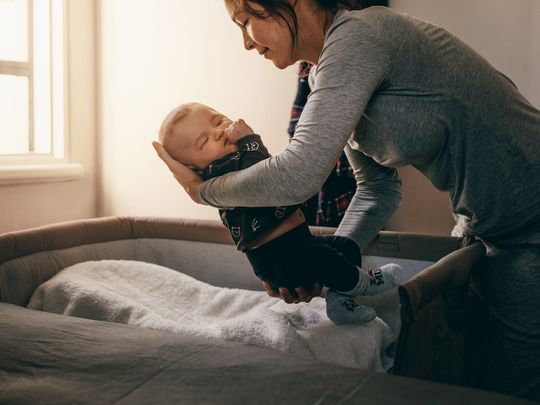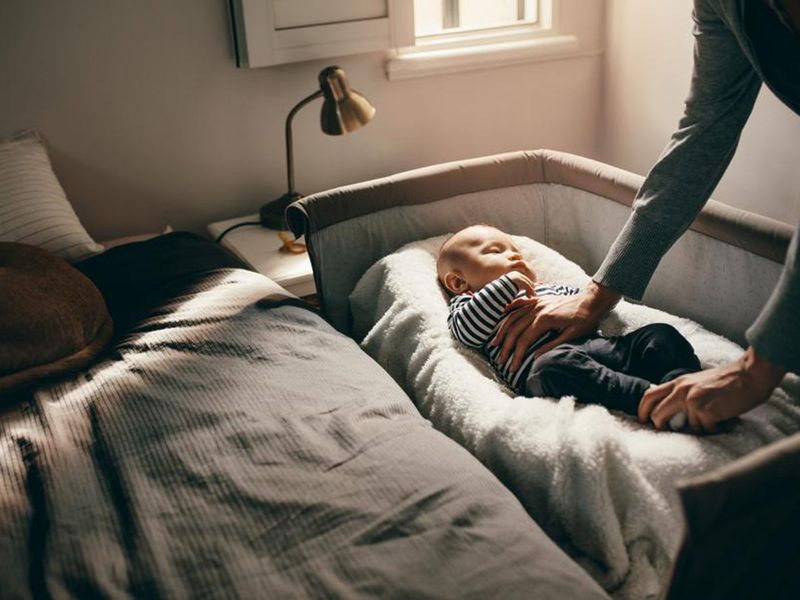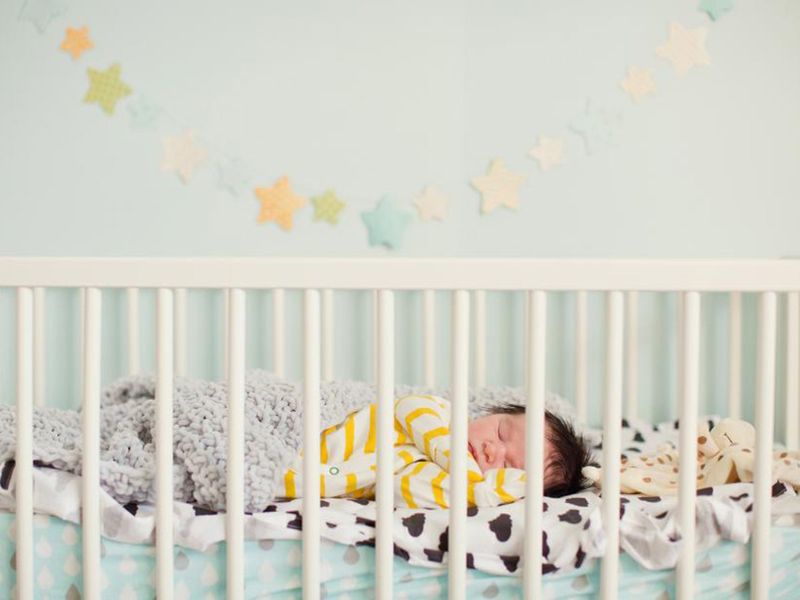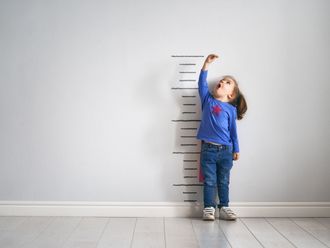
Listen in to the conversation at any new-mums’ circle and you’re sure to hear at least one parent swearing that their baby’s sleep pod, nest or positioner has been the miraculous secret to their child sleeping through the night from birth. Anecdotes abound and are tantalizingly glowing, while the trendy palm-print, marble and geometric designs, which some of the best-known sleep pod brands are bedecked in, mean that the products are easy-on-the-eye nursery accessories to boot. Designed to keep babies snuggled in a womb- or cuddle-like cosiness, these sleep aids are said to help babies sleep more soundly, sleep for longer, to keep them lying safely on their backs, and many even claim to help combat reflux and flat-head syndrome. All of which sounds ideal for the sleep-starved parent desperate for a few more hours of shuteye, right?
Perhaps not, says Julie Mallon, sleep consultant at UAE-based Nurture to Sleep, who says they have been cleverly marketed but have few real benefits and some serious safety concerns: "In the last 13 years there have been 12 deaths associated with sleep positioners," warns Julie. "The child either rolled over and had their faces pressed against the positioner, or got trapped between it and the side of the crib."
Popular uprising
To understand the popularity of sleep nests and positioners today, it’s useful to look at the history of safe sleeping guidelines for babies. Although a lot of babies tend to prefer to sleep on their fronts, "in 1994 the American Academy of Pediatrics started recommending that babies be put down to sleep on their backs rather than their fronts or sides, prompted by strong evidence that back-sleeping reduces the rate of SIDS [Sudden Infant Death Syndrome] or cot death," says Amy Vogelaar, midwife, lactation consultant and parenting educator at Love Parenting UAE. "Almost immediately, companies started marketing sleep positioners, wedges, hammocks and then nests and pods, with new ones coming out every year. These products promise that they will position babies on their backs ‘safely’, but will keep baby feeling cozy and contained, so that he or she will accept being put down to sleep, will accept sleeping on their back and will sleep for longer stretches at night. They also often promise colic or reflux relief, the prevention of head flattening, and more."
But it’s only in the past five years that these sleep aids seem to have gained mainstream hype, adds Julie Mallon – possibly due to the impact of their Instagram-friendly designs and some clever collaborations with influencers. Today, searching the social media site for hashtags of the most popular brands brings up millions of results – beautifully styled mummy-blog images of peacefully slumbering babies snuggled in their chic sleep nests, with captions championing their efficacy at getting little ones to nod off. Is it any wonder that they’ve become one of the latest mummy must-have?

The evidence against
Although their widespread popularity would have one believe that sleep nests are the answer to every slumber-deprived parent’s dreams, the experts would argue otherwise. Originally touted as a way to reduce the risk of SIDS, sleep positioners have actually been identified as a suffocation hazard, says Julie Mallon: "There have been numerous warnings from the 2010 Consumer Product Safety Commission (CPSC) and the US Food and Drugs Administration (FDA) against using sleep positioners," she says. "In 2015 Australia conducted a post-market review and concluded the use of sleep positioners to be unsafe. And in the UK Mothercare, John Lewis, Boots and Tesco have also taken them off the shelves following the Safe Sleep Guidelines." It’s worth noting that there is some confusion over exactly what a sleep positioner is and how it compares to a nest or pod. "Sleep positioners and baby nests are being incorrectly grouped together and are in fact quite different," says a spokesperson from the Baby Products Association, which represents baby product manufacturers in the UK. "Typically sleep positioners position a baby in a restrictive way, whereas nests provide a non-restrictive sleep surface/area. Whilst there is currently no safety standard specific to sleep positioners or baby nests, these products have evolved over the four to five years and are soft and made from air permeable materials such as 3D mesh and bamboo."
While the BPA believes that sleep positioners and baby nests are safe when used in proper accordance with the manufacturer’s guidelines, the US FDA warns strongly against them, while the British sleep safety charity the Lullaby Trust points out that the fact that pods and nests have mattresses with raised, padded sides means none of them meets the "flat, firm" sleep surface requirements of current safe sleep guidelines. "No positioner, nest or pod meets the current safe sleep guidelines of firm, flat sleep surfaces that do not have any sides or soft areas that can reduce air flow to the baby or that baby can get his or her face and nose pressed into and suffocate," agrees Amy Vogelaar. "It seems pretty obvious that a baby could get their face pressed into the side (or bottom) of a soft nest, especially if he or she rolls over onto their side or tummy. Babies roll by accident long before we realize they are going to do it, which is why we never leave them on a changing table unattended. Babies also wiggle more than we realize while they sleep, even when swaddled, and they will often travel to the less safe part of a product even if they are put down in the recommended position."
The Lullaby Trust’s director of services Jenny Ward is very clear: "We do not recommend the use of cushioned sleeping pods, nests, cot bumpers, pillows, duvets and sleep positioners. These items do not conform to safer sleep guidelines and could pose a risk to babies under 12 months. "Evidence shows that sleeping a baby on anything but a firm, flat surface, or using soft, heavy bedding can increase the risk of SIDS. They can lead to overheating or potentially obstruct a baby’s airway if they roll, or their head becomes covered."

What to do?
Both Amy and Julie empathise with parents who may be confused by the juxtaposition between the safe sleep guidelines and the fact that sleep nests and pods seem to be more popular than ever. "It’s hard for parents," says Julie. "They are bombarded with all these products they ‘must’ buy for their baby, which is a pressure in itself, and then, because these items are on sale, the presumption is they are safe."
Amy agrees. "There is always difficulty in finding the balance between the guidelines or rules and the practical reality of living with a baby and getting through your day without lots of other adults around to help hold and comfort your baby," she says. "I do make a point of warning parents, however, that new gadgets are not extensively tested or vetted, regardless of what their manufacturers and marketers say. And it is very common for them to be recalled and discontinued later on because of safety concerns and even because of known deaths and other hazards."
If you’ve already bought your sleep nest, Julie Mallon advises using it with caution – for practical as well as safety reasons. "I would advise that parents focus on developing healthy sleep habits right from the very start. If a parent is going to use a sleep positioner I would advise that they use it for only some of the child’s sleep, not all of it, so they don’t become dependent on it or form an unhealthy association. Just like a dummy, sleep positioners can be a short term fix that creates a long-term problem... The best way is to work with your baby so that they can sleep comfortably, on their back, with no restrictions."
"One of the most important misconceptions that I try to dispel is the very prevalent advice that parents ought to get babies sleeping for long stretches on their own
Finally, Amy is keen to point out the painful truth that the perennial parenting-Holy-Grail that is ‘sleeping through the night’ is not necessarily the safest thing for your child. "One of the most important misconceptions that I try to dispel is the very prevalent advice that parents ought to get babies sleeping for long stretches on their own," she says. "We know that the practices that are most protective against SIDS – such as sleeping on the back, sleeping in the same room as a parent, not being over-wrapped and not allowed to get too warm, and breastfeeding – all share one common feature: they lead to more light, active sleep in babies and less deep, quiet sleep. This means that babies sleep more lightly and wake more often, which seems to be protective against SIDS (because in long stretches of deep, quiet sleep some babies seem to be at risk of forgetting to breathe).
One of the reasons why sleep positioners, pods and nests are appealing is because they help babies sleep more deeply and for longer stretches without being held. This may be a high-risk situation for babies even without the added suffocation risks of soft sides and the possibility of baby rolling over!" "Ultimately, there is no scientific evidence to support medical claims about sleep positioners," concludes Julie. "All infants should sleep on their back without restraints, yet sleep positioners may cause suffocation of an airway, as they are fixed in one position. I would also recommend parents consult their practitioner before making any major changes to their babies sleep routine."
Read more:








